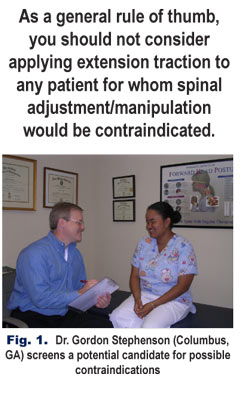So far, we’ve discussed a couple of different variations on extension traction methods for restoring the cervical lordosis. Before we move on, let me just say a few words regarding patient safety and extension traction procedures.
CAUTION: Extension traction procedures aren’t for everyone.
There I said it. Of course, I’ve been saying it constantly for the past twenty years or so. Nevertheless, I continue to run into doctors who have never screened a single patient before starting extension traction treatment. The purpose of this article is to get you, the doctor, focused on patient safety and to communicate what I know about the potential risks associated with extension traction procedures. Essentially, every therapeutic procedure carries with it some attendant risk and extension traction is no different. It is our duty to weigh potential risks against potential benefits. To minimize risks, it is important we do everything in our power to detect potentially “high risk” patients BEFORE they undergo any procedure which might carry with it an unacceptable level of danger.
I strongly believe we can minimize the risks associated with extension traction procedures by using simple, common sense screening procedures on every single patient before beginning treatment. That being said, there may still be some percentage of high risk patients who will slip through our safety net, for the simple reason that no screening procedure is likely to be 100 percent effective. I understand this whenever I consider using extension traction or any other type of therapy. You need to understand it, too. It is our duty to act according to the current state of knowledge; but, unfortunately, extension traction is still a relatively new procedure. The following information is the best I can offer you at this time. It is up to you, as the practitioner, to determine whether these methods are appropriate for each individual under your care.

As a general rule of thumb, you should not consider applying extension traction to any patient for whom spinal adjustment/manipulation would be contraindicated. By definition, extension traction procedures involve extension (backward bending) of the head and neck. Much has been written in the chiropractic literature about the possible dangers associated with extension of the head and neck, particularly when combined with cervical rotation. Although extension traction DOES NOT involve any rotation of the neck, it is still prudent to screen for any individuals who might be considered as “high risk” for physical treatment of the cervical spine.
During the patient history, you should screen for any conditions which might contribute to increased risk of injury/complications during extension traction and/or cervical spine manipulation. Such conditions might include: family history or predisposition to stroke; patient history of high blood pressure, hypertension, diabetes, atherosclerosis, arteriosclerosis, posterior osteophytic spurring, disc protrusion/prolapse, smoking, oral contraceptives, prolonged use of corticosteroids, Down’s Syndrome, or spinal stenosis. This list is not necessarily all inclusive; however, extreme caution is recommended if any of the above is present.
Contraindications
Factors which CONTRAINDICATE the use of extension traction include, but are not necessarily limited to: patient history of stroke or other cerebrovascular disease, a history of “drop attacks,” black outs, loss of consciousness, disturbances of vision and/or dizziness or vertigo associated with head positioning, history of transient ischemic attacks, spinal fracture or instability, spinal malignancy, infection or disease of the cord or column including advanced osteoporosis, and hemophilia or other blood clotting disorders including anticoagulant therapy. All are factors of sufficient seriousness and should be considered ABSOLUTE contraindications to any attempts at extension traction. In the case of lumbar extension traction, I believe that pregnancy and/or the presence of aortic aneurysm also present unacceptable risk factors.

Provided none of the above items is present, the patient is put through a simple five-step screening procedure which includes the entire George’s Test procedure (bilateral BP, radial pulse, carotid artery auscultation, and vertebrobasilar maneuver) as well as a trial period of extension traction. If any significant pain/discomfort or, more notably, any neurological symptom is noted at any point during the screening, the doctor should discontinue all further attempts at extension traction until the cause can be determined.
Extension traction has been widely used for well over twenty years now and has a remarkable record of safety. We can help keep this safety record intact by thoroughly screening every patient for possible risk factors or contraindications prior to starting any program of extension traction. The responsibility to “do no harm” rests with each of us.
For a more complete discussion of Patient Safety: Screening Procedures and Suggested Treatment Protocols for Extension Traction, call Dr. Payne at 1-334-448-1210 for his free report on Patient Safety. Dr. Mark R. Payne is the president of Matlin Mfg., a manufacturer and distributor of postural rehab products since 1988. To download a full and unabridged version of this article, link to www.MatlinMfg.com.
